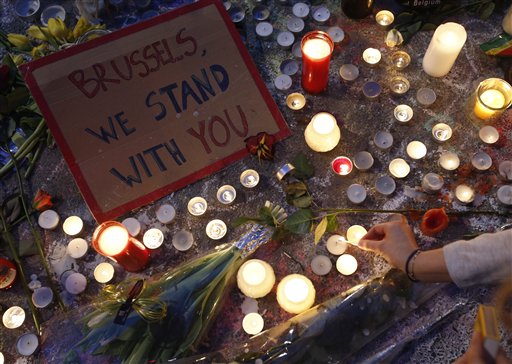‘Weeks’ to identify Brussels blast victims

A woman lights a candle amongst the tributes to the victims of the recent attacks in Brussels, placed in Place de la Bourse in the centre of Brussels, Thursday, March, 24, 2016. Belgium’s prime minister is promising to do everything to determine who was responsible for deadly attacks targeting the Brussels airport and subway system. Charles Michel, in a national mourning speech Thursday, said Tuesday’s attacks on the European Union’s capital targeted the “liberty of daily life” and “the liberty upon which the European project was built.”AP Photo
BRUSSELS, Belgium—Working with teeth, fingerprints and DNA, and sometimes relying on just tiny body parts, the forensic experts dealing with the victims of the Brussels attacks warn it could take weeks to identify them.
In a large military hospital complex in a leafy district north of Brussels, the experts are at work to establish the identities of corpses that have in many cases been left missing body parts by the blasts.
Guarded by heavily armed men in combat gear, the Reine Astrid hospital is being used as Belgium’s missing persons center, or Disaster Victim Identification (DVI) unit.
The painstaking nature of the work means families from around the world face a long and agonizing wait for the final confirmation that their loved ones were among the 31 people killed.
READ: Witness says ‘blood everywhere’ at Brussels airport
“Yesterday we had around 30 people here looking for family,” Ine Van Wymersch, who runs the center, told Agence France-Presse. “None of the bodies has yet been formally identified, the process is ongoing.”
Doctors, police, psychologists and Red Cross personnel are on hand to help people seeking news of missing relatives.
Nearly three days on, none of the bodies brought from the airport and train disaster scenes to the morgue has yet been formally identified and the process could take many more weeks.
Only once they have been identified will relatives be able to take the bodies away for funerals.
“The number of non-identified people is very, very exceptional,” federal police spokesman Michael Jonnois told AFP.
“It was an ‘open’ catastrophe, there was no list of who was in the train or at the airport terminal — there was no passenger list like when there’s a plane crash,” he said.
‘Heavy duty damage’
Jonnois said forensics experts collect wallets and jewelry and check details such as weight, height and hair color with relatives.
“We want to have 100 percent certainty. We cannot allow ourselves to have the slightest doubt.”
But with victims believed to come from up to 40 different countries, Philippe Boxho, head of the Liege university forensics department, says Interpol help may be needed and the process may be long.
READ: Brussels attack victims came from Belgium and around world
“They’ll be identified by their teeth, their DNA or their fingerprints — in that order,” he said.
“Teeth are quick, DNA takes a while longer and finger-prints only work if they’re already on file — though sometimes you can recover prints from their homes or workplaces.”
Dental checks could be carried out with help from dentists, DNA recovered by asking relatives to bring toothbrushes or other items, he said.
But this is more easily said than done when there is little or no means of identification and when victims live abroad. “It once took us three months to get DNA from a woman who lived in Berlin but who we first had to find,” he said.
Identification would likely be extremely difficult in the case of the Brussels attacks, he said, due to the violence of the three blasts, in which the Islamic State attackers used TATP high explosive packed with nails.
At the epicenter of an explosion, bodies “are completely destroyed, in tiny pieces, and at the periphery you find bodies that are more or less intact, missing body parts”.
“In this case there is probably some very heavy-duty damage,” Boxho said.
He said scientific identification was key to avoiding problems of mistaken identity, as asking family to identify victims visually was both psychologically difficult and unreliable.
“Some people are ready to recognize any corpse while others will refuse to, even if it’s the right one,” he said.














